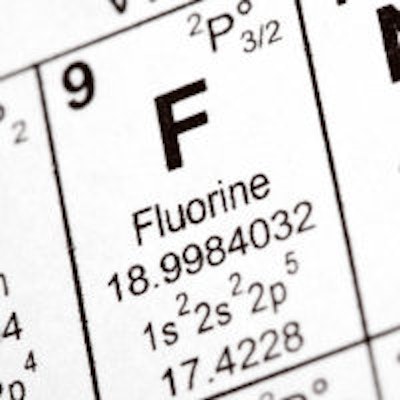
Fluoridation is effective at reducing levels of caries in children's teeth, according to a new review in the Cochrane Database of Systemic Reviews (June 18, 2015). But the researchers concluded there is not enough information to determine whether the introduction of fluoridation programs changed existing differences in caries across socioeconomic groups.
Caries is a major public health problem in most industrialized countries, affecting 60% to 90% of schoolchildren, the review authors noted. Community water fluoridation in the U.S. began in 1945; nearly 75% of Americans who use public water systems now get fluoridated water, according to the review. Fluoridation systems are currently used in about 25 countries worldwide.
Fluoride -- which occurs naturally in the soil, water, and atmosphere -- is also available in most toothpastes, and it can be provided as an extra preventive measure through products such as mouth rinses, varnishes, and gels.
“Community water fluoridation ... is the best method of delivering fluoride to all members of the community, regardless of age, education, income level, or access to routine dental care.”
The U.S. Centers for Disease Control and Prevention (CDC) considers water fluoridation one of the greatest public health achievements in the 20th century. Additionally, the ADA and the American Dental Education Association (ADEA) support and encourage fluoridation of community water supplies, as does the International Association of Dental Research, the National Institute of Dental and Craniofacial Research, and the World Health Organization.
In April, the U.S. Department of Health and Human Services issued a new recommendation for a single level of fluoride in community water systems of 0.7 mg/L (parts per million [ppm]) to maintain caries prevention benefits and reduce the risk of dental fluorosis in community water systems. The previous recommendation was a range of 0.7 mg/L to 1.2 mg/L, issued in 1962.
"Water fluoridation is effective and safe," said ADA President Maxine Feinberg, DDS, in a statement after the new fluoride levels were announced.
"The change in level recommended allows for these other sources of fluoride intake and will still maintain the protective benefit of fluoride, as well as reduce the likelihood of fluorosis," AAPD President Edward H. Moody Jr., DDS, told DrBicuspid.com after the announcement.
The American Dental Hygienists' Association (ADHA) has noted that fluoridated public water systems have significantly improved residents' oral health.
An unwanted effect of fluoride use is dental fluorosis that is caused when young children, whose permanent teeth are developing, swallow excessive fluoride. This can range from mild white patches on the teeth to severe mottling with brown staining.
Methods
In this latest review, Cochrane researchers sought to evaluate the effects of water fluoridation on preventing caries and also assess its effects on dental fluorosis.
They identified 155 studies up to February 2015 that met inclusion criteria in which children receiving fluoridated water, either natural or artificial, were compared with those receiving water with very low or no fluoride. The majority of studies (71%) were conducted prior to 1975 and the widespread introduction of the use of fluoride toothpaste. A further 135 studies examined dental fluorosis.
More than 97% of the 155 studies had a high risk of bias, which reduced the overall quality of the results, the reviewers noted. They also found a substantial variation among studies in terms of their results. Some 107 studies provided sufficient data for quantitative synthesis to be included in the review, the researchers stated.
The reviewers searched Cochrane databases, the U.S. National Institutes of Health Trials Registry, and the World Health Organization's International Clinical Trials Registry for ongoing trials.
For caries data, the review included only prospective studies with a concurrent control that compared at least two populations -- one receiving fluoridated water and the other nonfluoridated water -- with outcomes evaluated with at least two points in time. No studies that aimed to determine the effectiveness of water fluoridation for preventing caries in adults met the review's criteria.
Results
The data suggest that the introduction of water fluoridation resulted in a 35% reduction in decayed, missing, or filled primary teeth and a 26% reduction in decayed, missing, or restored permanent teeth, the review found. It also increased the percentage of children with no caries by 15%.
"Although these results indicate that water fluoridation is effective at reducing levels of tooth decay in children's baby and permanent teeth, the applicability of the results to current lifestyles is unclear because the majority of the studies were conducted before fluoride toothpastes and the other preventative measures were widely used in many communities around the world," the reviewers wrote.
"Our results suggest a complicated pattern of disease following cessation of fluoridation," they concluded. "Multiple sources of fluoride besides water fluoridation have made it more difficult to detect changes in the epidemiological profile of a population with generally low caries experience and living in an affluent setting with widely accessible dental services."
Commentary on the review
The CDC pointed out the many benefits that fluoridation provides.
"The biggest advantage of community water fluoridation is that it is the best method of delivering fluoride to all members of the community, regardless of age, education, income level, or access to routine dental care," wrote Katherine Weno, DDS, JD, in response to the review. Dr. Weno is the director of the Division of Oral Health for the CDC's National Center for Chronic Disease Prevention and Health Promotion.
Some fluoride supporters said the review's findings are being distorted by antifluoride groups. "Fluoride opponents are blatantly misrepresenting the report's findings to dishonestly use the authority of the Cochrane name to support antifluoride campaigns," Ken Perrott, PhD, scientific advisor for the Making Sense of Fluoride group, told DrBicuspid.com.
He also faulted Cochrane researchers for providing opportunities for "dishonest cherry-picking and distortion, because they did not qualify many of the statements made in the review's abstract and plain language summary."
"The exclusion of so many important studies meant the review was unable to come to any conclusions about important aspects like the effect of community water fluoridation [CWF] on socioeconomic difference in tooth decay, the effect of stopping CWF programs on later tooth decay, and the effectiveness of CWF in reducing adult tooth decay," Perrott added.
The CDC also criticized the reviewers' "restrictive criteria" for including studies in their analyses. "Although valid, peer-reviewed studies document the effectiveness of community water fluoridation in children and adults even after the use of fluoride toothpaste became widespread, these studies were not considered by Cochrane," Dr. Weno wrote.



















